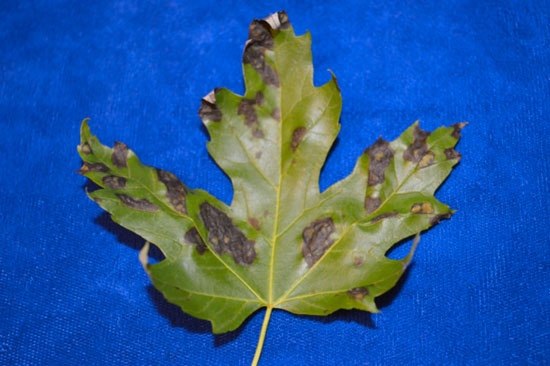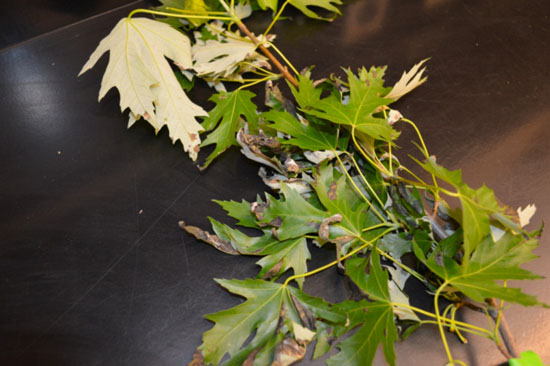Issue 5, May 28, 2013
Maple Blight Mania
This has been an interesting week at the Plant Clinic, with many samples and calls coming in regarding leaf blights on maple. The symptoms appear as brown to black spots and blotches on leaves, bordered by veins, as well as dark black blister spots and blotches that eventually take over the entire leaf. Eventually, the leaves will drop from the tree, which can cause the tree's appearance to be very, unsightly, and can be alarming to homeowners. In the lab, we have found that one leaf, such as that in the picture below, appears to be infected with one, two, and even three different fungal pathogens. The extended cool, wet weather this spring has been ideal for an epidemic of these leaf blighting pathogens. The fungal pathogens discovered on maple leaf samples at the Plant Clinic are discussed below.


Maple leaf infected with anthracnose, maple leaf blister, and Venturia leaf spot
Anthracnose (Discula spp., Kabatiella apocrypta)can occur each year on sycamore, maple, oak, ash, and other trees. Severity depends on the cultivar, susceptibility, and weather conditions. If conditions during the two weeks following bud break are cool and wet, anthracnose will be more severe. When young leaves are infected, leaves are often blackened. When older leaves are infected, the spots may be brown or tan, irregular shaped, and can be defined by veins.
Leaf blister of maple (Taphrina spp.) has been found to infect silver and red maples as well as their hybrids. Taphrina overwinters on twigs and leaf buds, also favors the cool, wet weather of spring, and infect leaves that are young and developing. As the leaves get older they become resistant to the fungus, so there is little chance of repeat infection in the same season. This pathogen will cause black, necrotic spots and blotches that are often raised, appearing as "blisters". Normally, these "blisters" develop on the leaf due to the secretion of fungal growth regulating chemicals that result in abnormal cell division and enlargement, which can give the leaves a curled and crinkled appearance. One way to distinguish a Taphrina infection from an anthracnose infection is that Taphrina usually does not cross leaf veins or infect the leaf petiole. Minnesota has observed "fast and furious" infections of Taphrina and these leaves did not show the characteristic blister symptoms. Purdue has also been reporting infection of leaf blister on maple in Indiana. For more information, you can refer to this link: http://www.ppdl.purdue.edu/PPDL/hot13/5-21.html
Venturia leaf spot (Venturia acerina) is another fungal disease similar to that of anthracnose and maple leaf blister that overwinters on leaves and infects maple leaves in the spring. Symptoms begin as dull, gray spots on leaves that grow and become velvety, brown and eventually black. The affected leaves wither and commonly drop prematurely.
The good news is that these diseases are mostly cosmetic and will not kill the tree. They may cause leaf drop now, but the tree will refoliate in June, as the new flush of leaves emerges in warmer and drier weather. Fungicides might have prevented these diseases, but they are only preventive. Once you see the disease, they are not helpful; therefore, fungicides are not recommended. Our recommendation is to help the tree put out new leaves by watering in periods of drought, removing dead wood, and fertilizing in the fall with a general tree fertilizer to help tree vitality. For more information on general leaf spot disease of shade and ornamental trees visit: http://ipm.illinois.edu/diseases/rpds/648.pdf (Stephanie Porter and Nick Prudhomme)